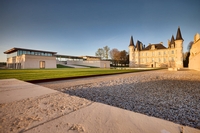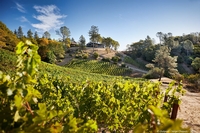Or the GEICO gecko pitching insurance policies while strolling through the barrel cellars at Ridge Vineyards?
And what about Allstate’s bruised and bandaged mayhem man running amuck on a farm tractor, chasing screaming wine tourists up and down the vineyard rows at Chateau Montelena? So much for being in good hands!
The idea that insurance companies would own premium wineries as financial investments and as prime venues for entertaining seems totally alien in the U.S., yet the practice is commonplace in France. There it is considered both sound business and great goodwill a practice fully sanctioned by the government.
Among these French insurance vignerons, none of is more prominent than AXA, the multinational insurance company headquartered in Paris. Not only does AXA own wine producers in France through its AXA Millésimes division, it also owns them in other countries – all premium producers with premium reputations.
In the U.S., they include Outpost, a top Cabernet Sauvignon brand on Howell  Mountain in Napa Valley, and the recently acquired Platt Vineyard on the Sonoma Coast. In Portugal, it owns Quinta do Noval, a well-regarded port producer in the Douro. Then there is Disznókő, which makes the classic dessert wine, Tokaji, in Hungary. In France, its properties are Domaine de L’Ardot in Burgundy, Château Suduaiau in Sauternes and, in Pauillac, Château Pibran and Château Pichon Baron, where the firm’s Millésimes subsidiary is headquartered.
Mountain in Napa Valley, and the recently acquired Platt Vineyard on the Sonoma Coast. In Portugal, it owns Quinta do Noval, a well-regarded port producer in the Douro. Then there is Disznókő, which makes the classic dessert wine, Tokaji, in Hungary. In France, its properties are Domaine de L’Ardot in Burgundy, Château Suduaiau in Sauternes and, in Pauillac, Château Pibran and Château Pichon Baron, where the firm’s Millésimes subsidiary is headquartered.
Other insurance companies own other wineries. Crédit Agricole, for example, owns châteaux Grand-Puy Ducasse and Meyney, both good wineries but more at the everyday level. None is more committed to having a premium winery portfolio than AXA.
The man in charge of all this is Christian Seely, a dapper, erudite Englishman who wouldn’t be caught drinking without his signature bow tie. Seely not only has an eye  for top properties that AXA can purchase and hopefully make even better, he employs his sophisticated palate to help guide his winemakers as well as use his thorough knowledge of the wine industry to encourage writers such as myself to seek out his properties.
for top properties that AXA can purchase and hopefully make even better, he employs his sophisticated palate to help guide his winemakers as well as use his thorough knowledge of the wine industry to encourage writers such as myself to seek out his properties.
To make him even more of a renaissance wine person, Seely is also founder and co-owner with Nicholas Coates of a premium sparkling wine company, Coates & Seely, on the chalk-layered downs of Hampshire near the English Channel.
I first met Seely during the 2017 barrel tastings of the 2016 vintage en primeur at Château Baron in Bordeaux over a group lunch of pâte of smoked salmon en gelée with arugula and then poulet with morel sauce and roasted potatoes paired with recent vintages of his wines. I asked him about AXA’s acquisitions philosophy. “We look for premium wine properties which we believe we can manage well and add value,” he explained. The “add value” part is important, he said, because while he and AXA are only interested in buying well-run, well-respected estates, they usually have in mind ways of improving things, hopefully both commercially as well as artistically.
That also means helping a winery decide on strategies and how to meet them, including marketing decisions. For example, at the same lunch, we were served a white wine from Baron’s sister property in Sauternes, Château Suduiraut, but it wasn’t a dessert wine. At that time, Sauternes wineries were debating whether to also produce white table wines from their Sauvignon Blanc and Semillon grapes because the dessert wines weren’t selling well.
Some châteaux were already producing both, but others were sticking to their historic brand positioning. The white we were served was the 2016 “S du Suduiraut Sec,” and Seeley said the estate had introduced the dry wine in 2003. He was firmly of the belief that revenues from dry wines from Sauternes help preserve the traditional sweet ones.
Most of our subsequent conversations have been by phone or email whenever I wanted his opinion on a particular topic, although I did say hello a couple of times in New York when top Port producers came calling to introduce their new vintages to the wine trade and offer the wine media a preview and a presentation.
A couple of weeks ago, I followed up, contacting him with a question about the use of Alicante Bouschet in some vintage Ports – Are you doing this at Noval? “At one hectare out of our 192 hectares of planted vines, it is a pretty minor element for us,” Seely said, noting, “It goes into the blends for our red wines.” And thus, he has no plans to increase or decrease plantings.
A couple of years ago, I wrote an article for the World of Fine Wine on what I called the “Frenchification” of Napa Valley – the fact that more than 25 Napa wineries have French owners, including AXA’s purchase in 2011 of Outlook, as well as a large number of French winemakers and consultants. I noted that most Napa producers were more than happy to hear French being spoken in the Oakville Grocery, a further validation that U.S. terroir is as good as French terroir, and Napa Cabernets are worth their astronomical prices.
For the article I asked Seely why AXA became interested in an American purchase. “Our underlying principle is to find a great terroir, one among the best in its category, and look after it as a long-term investment,” he reiterated. “I had one or two people helping me in Napa, and I spent a couple of years personally looking at many properties. I also talked with other French owners of Napa Valley properties. Christian Moueix was particularly helpful, as he always is.”
More recently, I was in Napa on assignment in February and had a chance to visit Outlook atop Howell Mountain. Founder and now director of Outpost, Frank  Dotzler, had angled for the AXA purchase when he decided to sell and said that he was delighted when Seely asked him to remain as winery director. Seely agreed to continue production of a varietal Outpost Zinfandel because of its high ratings and Dotzler’s attachment to it, even though adding more Cabernet Sauvignon vines would have been more profitable. The added AXA touch, however, was to have Dotzler purchase a nearby quality Cabernet vineyard to expand production and also to create a “second wine” in addition to the “estate wine,” the way they do in Bordeaux.
Dotzler, had angled for the AXA purchase when he decided to sell and said that he was delighted when Seely asked him to remain as winery director. Seely agreed to continue production of a varietal Outpost Zinfandel because of its high ratings and Dotzler’s attachment to it, even though adding more Cabernet Sauvignon vines would have been more profitable. The added AXA touch, however, was to have Dotzler purchase a nearby quality Cabernet vineyard to expand production and also to create a “second wine” in addition to the “estate wine,” the way they do in Bordeaux.
Beyond that, he tasked Dotzler with finding a premium Pinot Noir producer, which Dotzler did in 2022 with Platt Vineyard on the Sonoma Coast. Although the vineyard was not a winery, AXA kept the vineyard name, again the way most châteaux in Bordeaux and domaines in Burgundy maintain identities rather than reinventing new ones.
And, unlike most wineries in fire-prone Northern California, neither Platt nor Outpost has to worry about buying an insurance policy.
